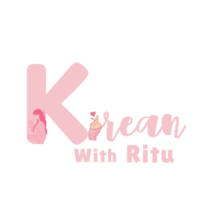Our Korean Present Tense Practice Worksheets offers both guided and worksheets without guidelines designed specifically for beginners. This resource provides a structured, interactive way to reinforce and practice present tense conjugations and all its rules, making it an essential tool for self-learners, teachers, and students alike. Here’s an overview of what this resource offers and how to make the most of it.
It consists of total of 54 Pages including surprise bonus practice exercises.
What it Offers:
- Korean verbs & Adjectives, and speech levels
- Detailed explanation on Korean Present tense- Informal and Formal endings
- Conjugation rules of Korean present tense
- Exceptions in Korean present tense
- Worksheets with guidelines
- Worksheets without guidelines
1. Korean Verbs & Adjectives, and Speech Levels
- Verbs & Adjectives: Korean grammar uses both verbs and adjectives as predicates (the part of a sentence that gives information about the subject). These worksheets introduce the most commonly used Korean verbs and adjectives, helping learners understand their roles in sentences and how they change when conjugated in the present tense.
- Speech Levels: Korean has multiple speech levels to reflect varying degrees of formality, respect, and familiarity. The worksheets cover:
- Informal Speech (반말), typically used with close friends or younger people.
- Polite Speech (존댓말), used in most social and professional contexts.
- Formal Speech (높임말), reserved for formal situations, such as speaking to superiors or in formal presentations.
- By practicing conjugations across these levels, learners gain confidence in adjusting their language appropriately depending on the social context.
2. Detailed Explanation of Korean Present Tense Endings: Informal and Formal
- Present Tense Endings: Korean present tense endings differ depending on the level of speech. The worksheets explain these variations:
- Informal: In casual or informal situations, present tense verbs end in “-아/어” (depending on vowel harmony) for both verbs and adjectives.
- Example: 가다 (to go) becomes 가 ga + 아 a = 가 ga + 아요 ayo or 가요 gayo.
- Polite: In polite speech, the ending “-아요/어요” (depending on vowel harmony) is added to verbs and adjectives.
- Example: 가다 (to go) becomes 가요 gayo in polite speech.
- Formal: The ending “-습니다/ㅂ니다” is used in formal speech and shows a high level of respect.
- Example: 가다 (to go) becomes 갑니다 gamnida in formal situations.
- Informal: In casual or informal situations, present tense verbs end in “-아/어” (depending on vowel harmony) for both verbs and adjectives.
- Examples & Application: Each worksheet provides multiple example sentences, showing how different verbs and adjectives are used across informal, polite, and formal levels.
3. Conjugation Rules of Korean Present Tense
- Stem + Ending Structure: Korean conjugation is based on attaching endings to the verb or adjective stem. The worksheets explain how to identify the verb stem (by removing “-다” from the dictionary form of the verb).
- Vowel Harmony: Korean follows vowel harmony rules, meaning the ending changes based on whether the final vowel in the verb stem is an open vowel (아, 오) or closed vowel (어, 우, 이, etc.).
- Example: 좋다 (to be good) becomes 좋아 (informal), 좋아요 (polite), and 좋습니다 (formal).
- Batchim (받침): The presence or absence of a final consonant (batchim) in the verb stem affects the conjugation. The worksheets outline these rules clearly, helping learners apply them consistently.
- Example: With a verb like 먹다 (to eat), which has a batchim, you would say 먹어요 (polite) in the present tense.
4. Exceptions in Korean Present Tense
- Irregular Verbs: Some Korean verbs and adjectives are irregular, meaning they don’t follow the standard conjugation rules. The worksheets provide a list of the most common irregular verbs, including:
- ㄷ Irregulars: Where ㄷ changes to ㄹ when a vowel follows.
- Example: 듣다 (to listen) becomes 들어요 in the polite present tense.
- ㅂ Irregulars: Where ㅂ changes to 우 when followed by a vowel.
- Example: 돕다 (to help) becomes 도와요 in the polite present tense.
- 르 Irregulars: Where 르 is replaced with an extra ㄹ in certain contexts.
- Example: 빠르다 (to be fast) becomes 빨라요.
- ㄷ Irregulars: Where ㄷ changes to ㄹ when a vowel follows.
- Special Conjugation Rules: The worksheets also cover a few special cases, such as the handling of 하다 verbs (often “to do” verbs), which have unique conjugation forms. For example, 하다 (to do) becomes 해요 in the polite present tense.
5. Worksheets with Guidelines
- Guided Conjugation Practice: These worksheets offer step-by-step instructions for conjugating verbs in the present tense, making it easy for beginners to learn the basics.
- Step-by-Step Instructions: Each guided worksheet starts with identifying the verb stem, determining if there’s a final consonant (batchim), and selecting the correct present tense ending based on speech level.
- Examples & Practice: After an explanation of the rules, each section includes practice verbs with prompts and examples, allowing learners to apply the rules immediately.
- Checklists: Some guided worksheets include checklists, so learners can ensure they’re following each conjugation step correctly.
6. Worksheets without Guidelines
- Independent Practice: These worksheets are designed for learners to apply what they’ve learned without any guidance. They include a list of verbs and adjectives that learners can conjugate on their own across the different speech levels.
- Self-Assessment Opportunity: By working through these blanks, learners can test their understanding of conjugation rules and identify any areas that need further review.
- Customization: The blank worksheets can be reused and customized with new verbs and adjectives as learners progress, making them a flexible tool for ongoing practice.
The Korean Present Tense Practice Worksheets provide a comprehensive yet beginner-friendly way to master Korean present tense conjugation. Through guided and independent practice, learners gain a solid understanding of essential grammar rules, tackle irregular verbs, and apply what they’ve learned across various speech levels. This professional, friendly resource is perfect for building a strong foundation in Korean, one worksheet at a time.











Reviews
There are no reviews yet.